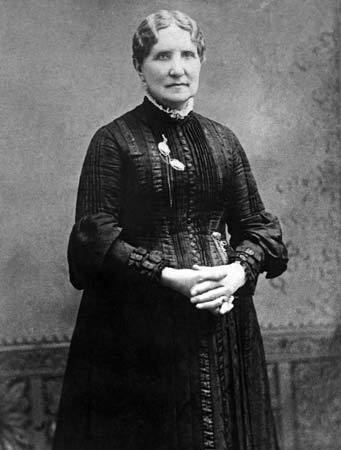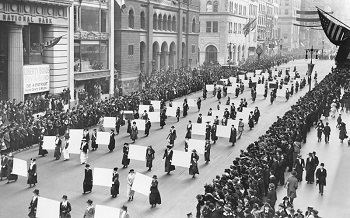Spouse(s) Daniel P. Livermore Name Mary Livermore | ||
 | ||
Books The Story of My Life or The Sunshine and Shadow of Seventy Years | ||
Mary livermore s 96th birthday party with dean martin clip 06
Mary Livermore, born Mary Ashton Rice, (December 19, 1820 – May 23, 1905) was an American journalist, abolitionist, and advocate of women's rights.
Contents
- Mary livermore s 96th birthday party with dean martin clip 06
- Mary Livermore Quotes
- Early years and education
- Career
- American Civil War
- Post war life
- Legacy
- Selected works
- References

When the American Civil War broke out, she became connected with the United States Sanitary Commission, headquarters at Chicago, performing a vast amount of labor of all kinds—organizing auxiliary societies, visiting hospitals and military posts, contributing to the press, answering correspondence, and other things incident to the work done by that institution. She was one of those that helped organize the great fair in 1863, at Chicago, when nearly US$100,000 was raised, and for which she obtained the original draft of the Emancipation Proclamation from President Lincoln, which was sold for $3,000.

When the war was over she instituted a paper called the Agitator, which was afterwards merged in the Woman's Journal. Of this, she was editor for two years and a frequent contributor thereafter. On the lecture platform, she had a remarkable career, speaking mostly in behalf of women's suffrage and the temperance movements. Many years, she traveled 25,000 miles (40,000 km) annually, speaking five nights each week for five months of the year.

Her printed volumes included: Thirty Years Too Late, first published in 1847 as a prize temperance tale, and republished in 1878 ; Pen Pictures; or, Sketches from Domestic Life, What Shall We Do with Our Daughters? Superfluous Women, and Other Lectures, My Story of the War. A Woman's Narrative of Four Years' Personal Experience as Nurse in the Union Army, and in Relief Work at Home, in Hospitals, Camps and at the Front during the War of the Rebellion. For Women of the Day, she wrote the sketch of the sculptress, Miss Anne Whitney; and for the Centennial Celebration of the First Settlement of the Northwestern States, at Marietta, Ohio, July 15, 1788, she delivered the historical address.
Mary Livermore Quotes
Early years and education
Mary Ashton Rice was born in Boston, Massachusetts on December 19, 1821 to Timothy Rice and Zebiah Vose (Ashton) Rice. She was a direct descendant of Edmund Rice, an early Puritan immigrant to Massachusetts Bay Colony. Livermore came from a military family: her father fought in the War of 1812 and her mother was a descendant of Captain Nathaniel Ashton of London. Livermore was incredibly intelligent, graduating from Boston public schools at age 14. Because there were no public high school or college options for women of that time, she attended school at an all-female seminary in Charlestown, Massachusetts, and read the entire Bible every year until the age of 23.
Career
After graduating from the seminary in 1836, she stayed there as a teacher for two years. In 1839, she started a job as a tutor on a Virginia plantation, and after witnessing the cruel institution of slavery, she became an abolitionist. She also began work with the temperance movement at this time, identified with the Washington Temperance Reform and an editor for a juvenile temperance paper. In 1842, she left the plantation to take charge of a private school in Duxbury, Massachusetts, where she worked for three years. She also taught at Charlestown, Massachusetts.
She married Daniel P. Livermore, a Universalist minister in May 1845, and in 1857, they moved to Chicago. In that year, her husband established the New Covenant, a Universalist journal of which she became associate editor for twelve years, during which time she frequently contributed to periodicals of her denomination and edited the Lily.
As a member of the Republican party, Livermore campaigned for Abraham Lincoln in the 1860 presidential election. In the Chicago Wigwam in 1860, Livermore was the only woman reporter assigned a location for work amidst over hundreds of male reporters. She published a collection of nineteen essays entitled Pen Pictures in 1863.
American Civil War
During the Civil War, she volunteered as an associate member of the United States Sanitary Commission at 40 years old. As agent of its Chicago branch, later named the Northwestern branch, she attended a council of the National Sanitary Commission at Washington in December 1862, organized many aid societies, visited army posts and hospitals, and in 1863, organized the North-western Sanitary Fair in Chicago which raised $86,000. President Lincoln donated his own copy of the Emancipation Proclamation, which was auctioned off at $10,000. Livermore eventually became the co-director of the Chicago branch with Jane Hoge, another soldier's aid advocate. The two women completed a hospital inspection tour across Illinois, Kentucky, and Missouri. With a thorough understanding of the needs of the hospitals, Hoge and Livermore sent $1 million worth of food and supplies to hospitals and battlefields most in need.
Livermore, like many other nurses, came up against the issue of women disguised as male soldiers. On a visit to the camp of the 19th Illinois Infantry, a captain pointed out a soldier to Livermore, asking if she noticed anything odd about them. Livermore confirmed the captain's suspicions that the soldier was indeed a woman. The captain called the soldier for questioning, and though she pleaded to stay in service near her beloved, Livermore escorted her out of camp. The soldier escaped Livermore, however, and fled.
In addition to her nursing services, Livermore was also a prolific writer. She authored numerous books of poetry, essays, and stories, and was a recognized member of the literary guild. Though Livermore had to sacrifice much of her social justice work for nursing, she still managed to publish some kind of content once a week throughout the entirety of the war.
Post-war life
After the war Livermore devoted herself to the promotion of women's suffrage (along with Lucy Stone and Julia Ward Howe ) and the temperance movement, founding in Chicago in 1869 The Agitator, which in 1870, after she moved to Boston, was merged into the Woman's Journal, of which she was an associate editor until 1872. Livermore became the first president of the Association for Advancement of Women, as well as president of American Woman Suffrage Association.
Like many Universalists of the time, she was interested in spiritualism, and following her husband's death in 1899, she became convinced that he had communicated with her through a medium. Livermore died in Melrose, Massachusetts.
Legacy
Nearly four decades after her death, she became the namesake of a World War II Liberty ship, the SS Mary A. Livermore.
